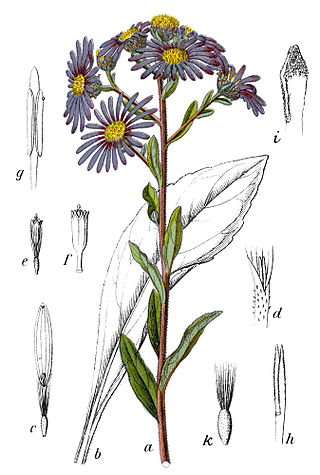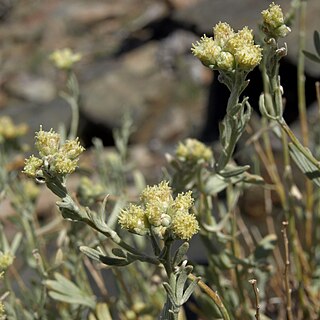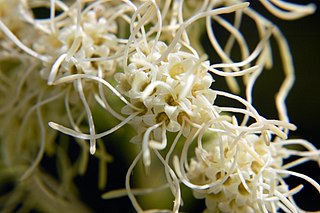
Asteraceae is a large family of flowering plants that consists of over 32,000 known species in over 1,900 genera within the order Asterales. The number of species in Asteraceae is rivaled only by the Orchidaceae, and which is the larger family is unclear as the quantity of extant species in each family is unknown. The Asteraceae were first described in the year 1740 and given the original name Compositae. The family is commonly known as the aster, daisy, composite, or sunflower family.

Iva annua, the annual marsh elder or sumpweed, is a North American herbaceous annual plant in the family Asteraceae that was historically cultivated by Native Americans for its edible seed.

Symphyotrichum is a genus of over 100 species and naturally occurring hybrids of herbaceous annual and perennial plants in the composite family, Asteraceae, most which were formerly treated within the genus Aster. The majority are endemic to North America, but several also occur in the West Indies, Central and South America, as well as one species in eastern Eurasia. Several species have been introduced to Europe as garden specimens, most notably New England aster and New York aster.

Astereae is a tribe of plants in the family Asteraceae that includes annuals, biennials, perennials, subshrubs, shrubs, and trees. They are found primarily in temperate regions of the world. Plants within the tribe are present nearly worldwide divided into over 250 genera and more than 3,100 species, making it the second-largest tribe in the family behind Senecioneae.

A pseudanthium is an inflorescence that resembles a flower. The word is sometimes used for other structures that are neither a true flower nor a true inflorescence. Examples of pseudanthia include flower heads, composite flowers, or capitula, which are special types of inflorescences in which anything from a small cluster to hundreds or sometimes thousands of flowers are grouped together to form a single flower-like structure. Pseudanthia take various forms. The real flowers are generally small and often greatly reduced, but the pseudanthium itself can sometimes be quite large.

Coreopsis rosea is a North American species of Coreopsis in the family Asteraceae. It has a discontinuous distribution in the eastern United States and Canada, found in Nova Scotia, Massachusetts, Rhode Island, New York, New Jersey, Pennsylvania, Delaware, Maryland, Georgia, and South Carolina.

Asteroideae is a subfamily of the plant family Asteraceae. It contains about 70% of the species of the family. It consists of several tribes, including Astereae, Calenduleae, Eupatorieae, Gnaphalieae, Heliantheae, Senecioneae and Tageteae. Asteroideae contains plants found all over the world, many of which are shrubby. There are about 1,135 genera and 17,200 species within this subfamily; the largest genera by number of species are Helichrysum (500–600) and Artemisia (550).

Gutierrezia microcephala is a species of flowering plant in the family Asteraceae known by the common names sticky snakeweed, threadleaf snakeweed, threadleaf broomweed, and smallhead snakeweed. It is a subshrub native to the southwestern United States and northern Mexico, and can be found in arid grassland and desert sand dune habitats. It can be toxic to livestock in large quantities, due to the presence of saponins and high concentrations of selenium.

Gutierrezia sarothrae is a species of flowering plant in the family Asteraceae known by the common names broom snakeweed, broomweed, snakeweed, and matchweed. It is a subshrub native to much of the western half of North America, from western Canada to northern Mexico, and can be found in a number of arid, grassland, and mountain habitats. It can be toxic to livestock in large quantities, due mainly to the presence of saponins.

Symphyotrichum sericeum is a species of flowering plant in the family Asteraceae native to central North America. Commonly known as western silver aster, western silvery aster, and silky aster, it is a perennial, herbaceous plant that may reach 70 centimeters tall. Its flowers have purple ray florets and pink then purple disk florets, and its leaves are firm and silvery-green.

Amphiachyris is a genus of flowering plants in the family Asteraceae described as a species in 1840.
Columbiadoria is a small North American genus of flowering plants in the family Asteraceae.

Thurovia is a genus of Texan plants in the tribe Astereae within the family Asteraceae.

Sphaeromeria cana is a species of flowering plant in the family Asteraceae known by the common name gray chickensage. It is native to the western United States, where it is known from the Sierra Nevada, the adjacent desert ranges of eastern California and Nevada, and Steens Mountain of Oregon. It grows in dry, rocky mountain habitat, such as cracks and crevices, including the talus above the tree line. This is an aromatic subshrub with numerous erect branches growing up to 30 to 60 centimeters tall. It is gray-green in color and coated with woolly fibers. The leaves are linear or lance-shaped, the lower ones divided into lobes. The inflorescence is generally a cluster of flower heads lined with woolly phyllaries and containing yellow disc florets. There are no ray florets. The fruit is a ribbed achene about 2 millimeters long.
Amphiachyris amoena is a North American species of flowering plants in the family Asteraceae. It is found only in central and north-central Texas in the United States.
Asanthus squamulosus is a North American species of plants in the family Asteraceae. It is native to northern Mexico, and the southwestern United States. Common name is Mule Mountain false brickellbush.

Brickellia eupatorioides, or false boneset, is a North American species of flowering plants in the family Asteraceae. It is widespread in Mexico from Chihuahua to Oaxaca, and in all regions of the contiguous United States except New England, New York, and the West Coast.
Ericameria arizonica is a North American species of flowering shrub in the family Asteraceae known as Arizona goldenbush or Grand Canyon goldenweed. It has been found only on the cliffs on the south rim of the Grand Canyon in Coconino County, Arizona.
Eucephalus elegans is a North American species of flowering plants in the family Asteraceae known by the common name elegant aster. It is native to the western United States, largely the Great Basin, in the states of Colorado, Idaho, Montana, Nevada, Oregon, Utah, Wyoming.

Symphyotrichum racemosum is a species of flowering plant native to parts of the United States and introduced in Canada. It is known as smooth white oldfield aster and small white aster. It is a perennial, herbaceous plant in the family Asteraceae. It is a late-summer and fall blooming flower.















